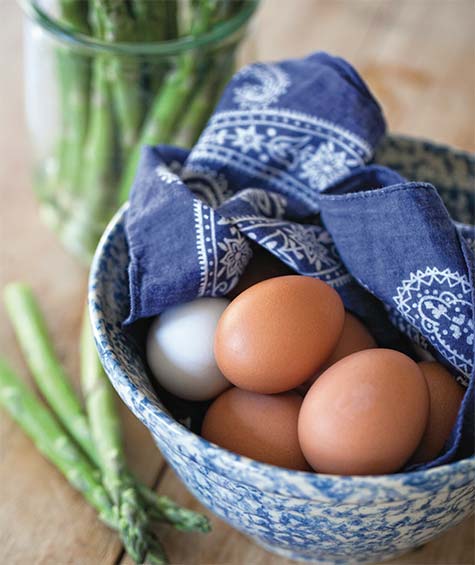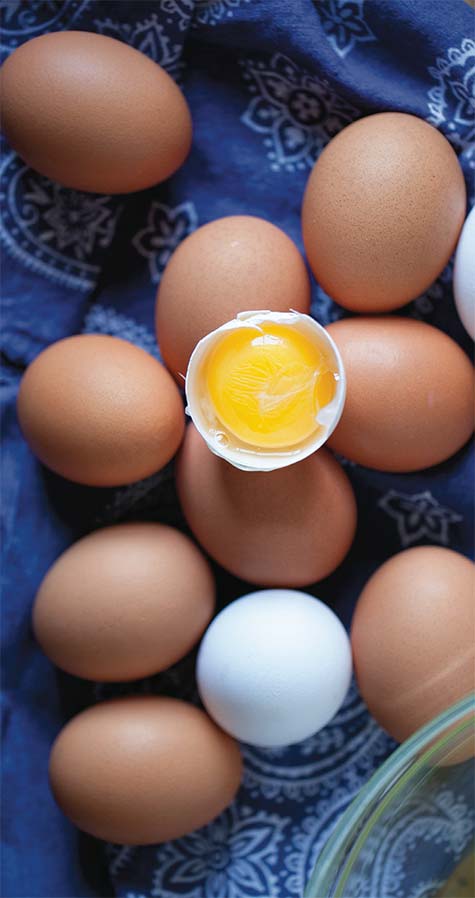
Recipes and photography by Kelly Yandell, themeaningofpie.com
Whether dressed up or simply scrambled, eggs are one of your kitchen’s most versatile and economical staples. No matter the time of day, with a carton of eggs on hand, it doesn’t take much more to create a healthy, filling meal. Here are four recipes that pair the nutritious little egg with spring’s freshest ingredients. Our test kitchen used locally sourced eggs from Fruth Farms, bacon from SMOKE and bread from Empire Baking Company.
RECIPES
Asparagus and Hollandaise Stack

A FEW FACTS ABOUT EGGS
Eggs from Fruth Farms
Photography by Kelly Yandell
Eggs are a simple, age-old staple. But these days there is nothing simple about buying eggs. Between grades, sizes, claims regarding hens’ living conditions and other labeling information stamped on its side, an egg carton can be a maze of information. Some forgo the box shorthand and seek out eggs gathered by small, local egg producers.
Eggs found at farmers markets oft en come from flocks with varied breeds, the result of which is a beautiful array of pastel and earth-toned orbs. The determiner of shell color is the breed of the laying hen. As lovely as multi-colored eggs may be, shell color does not equate to a more nutritious egg nor does it affect the taste of what’s inside the shell. You can usually tell the color of a hen’s eggs by the color of its earlobes. A hen with white earlobes, for instance, lays white eggs and a hen with red earlobes lays tinted eggs. All eggs are white at the beginning of their approximately 24-hour journey through the hen’s oviduct. But different breeds produce pigments that tint the shell as it forms. An Ameraucana bird, for instance, deposits the pigment oocyanin resulting in a blue-hued shell. Chickens that lay brown-tinted eggs deposit the pigment protoporphyrin.
The yolk of an egg reveals the diet of the hen. Pasture-raised birds, which tend to have access to all manner of interesting bugs and grasses, yield a rich golden, almost orange yolk, though this will vary with the seasons, depending on what’s available for them to eat.
When cooking with ungraded eggs from your backyard flocks, consider the size of your egg in recipes where precision is important. For frying up breakfast, the size really isn’t a concern, but for baking, the amount of “egg in the egg” is critical. In a recently purchased carton of local eggs, the selections ranged from 2 ounces to a whopping 4 ounces, in the shell. That would have a pronounced effect on many recipes. Just remember that a standard large egg is 2 ounces and that is what most recipes call for. Adjust accordingly.
Whichever kind or color of eggs you choose, know that most farmers are proud to talk about their hens. Ask questions. Does the chicken have a varied, natural diet supplemented by grains? Does the flock have access to the outdoors? That is the upside to supporting local farmers, and having a relationship with those who grow and raise your food.
A BRIEF REVIEW OF LABELS
Don’t be fooled by marketing claims like “all-natural” and “farm fresh,” or by illustrations of cheery chickens feasting beside red barns. Cheap food oft en comes at a price. Factory-farmed eggs are produced by caged hens confined to a space smaller than a sheet of paper.
The USDA oversees the Certified Organic label but most other claims are voluntary. Third-party certifiers, like Certified Humane and American Humane Certified, off er additional guidance. For more information, go to the USDA or Humane Society websites. Or better yet, head to a farmers market and chat with an egg farmer.
Pastured or Pasture-Raised: Ideally, hens spend their days outdoors eating grasses, foraging for insects and engaging in natural behaviors. They may be housed, particularly at night, in protective portable shelters that are moved periodically to fresh pastures. There are no set regulations regarding feed. Label may be verified by third-party certification.
Certified Organic: Hens have an organic diet, free of pesticides, animal by-products and GMOs. They are uncaged and offered outdoor access, though the quality of that space and the duration of time spent there is not specified. Producers must meet USDA requirements and are inspected regularly.
Free-Range: Hens are uncaged and given access to the outdoors, though the quality of that space and duration of time spent there varies, unless third-party certified. There are no set specifications regarding feed.
Cage-Free: Hens are usually raised inside a building or enclosed area but are not confined to cages. Unless third-party certified, there are no set specifications regarding amount of space allotted to each hen. There are no set specifications regarding feed.
KELLY YANDELL is a writer and photographer based in Dallas. She has contributed to Edible Dallas & Fort Worth since 2011. Her website (themeaningofpie.com) celebrates practical dishes and comfort foods, while her photography portfolio can be found at kellyyandell.com. Kelly is an attorney and is the vice president of the Advisory Board of Foodways Texas, an organization founded by scholars, chefs, journalists, restaurateurs, farmers, ranchers, and other citizens of the state of Texas who have made it their mission to preserve, promote and celebrate the diverse food cultures of Texas.
-
Kelly Yandellhttps://www.edibledfw.com/author/kyandell/
-
Kelly Yandellhttps://www.edibledfw.com/author/kyandell/
-
Kelly Yandellhttps://www.edibledfw.com/author/kyandell/
-
Kelly Yandellhttps://www.edibledfw.com/author/kyandell/











